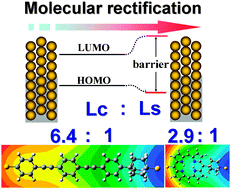We studied the contact coupling effect on the asymmetric electron transport in molecular junctions by the first-principles density functional theory incorporating with the non-equilibrium Green’s function method. To realize the decoupling, a rigid saturated ring is inserted into the metallic electrode and conjugated molecular bridge (linear oligo phenylene ethynylene and cyclic porphine). As a tunneling barrier, the saturated ring reduces the conductance by 2–3 orders of magnitude. However, the electronic decoupling greatly improves the asymmetric electron transport. In the case of the linear system, the favorite direction of electron transport is from the strong coupling end to the weak coupling one with a rectification ratio of 5 at 2.0 V. In addition, the rectification performance is sensitive to the molecular proportion of the molecular wire length and the tunneling barrier width. When the same barrier is applied, shortening the length of conjugated part can reduce rectification performance. The mechanism of rectification is analyzed by means of the potential drop, the spatial distribution of the molecular orbitals and the transmission spectra.

You have access to this article
 Please wait while we load your content...
Something went wrong. Try again?
Please wait while we load your content...
Something went wrong. Try again?


 Please wait while we load your content...
Please wait while we load your content...